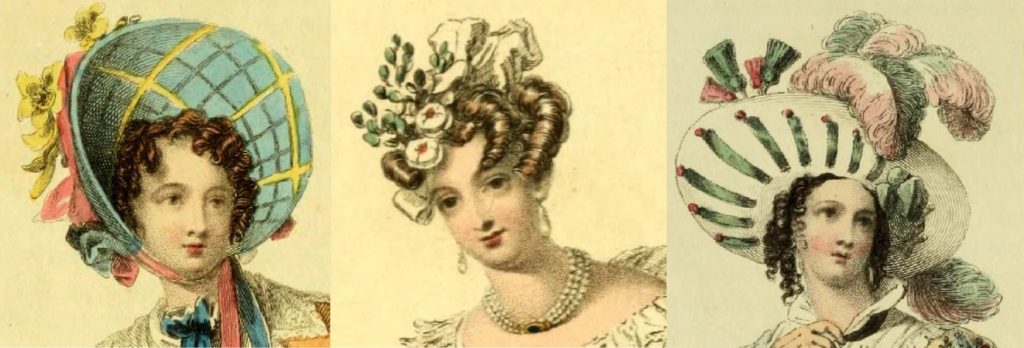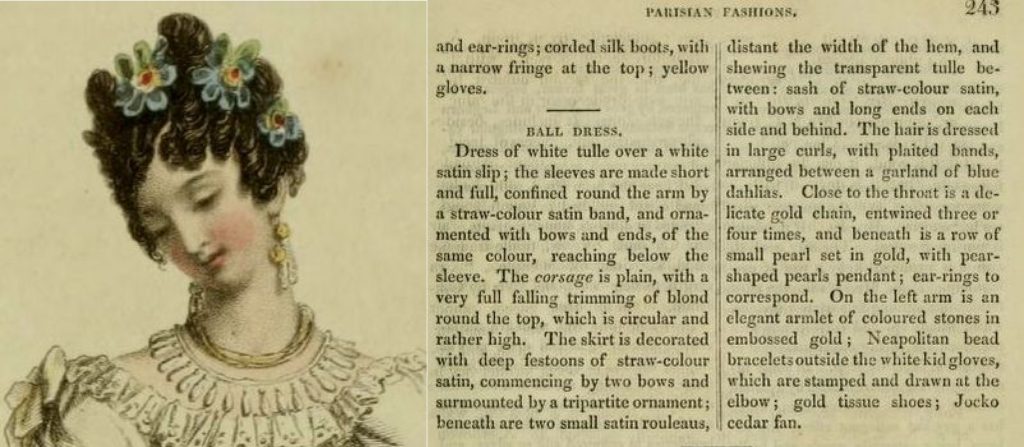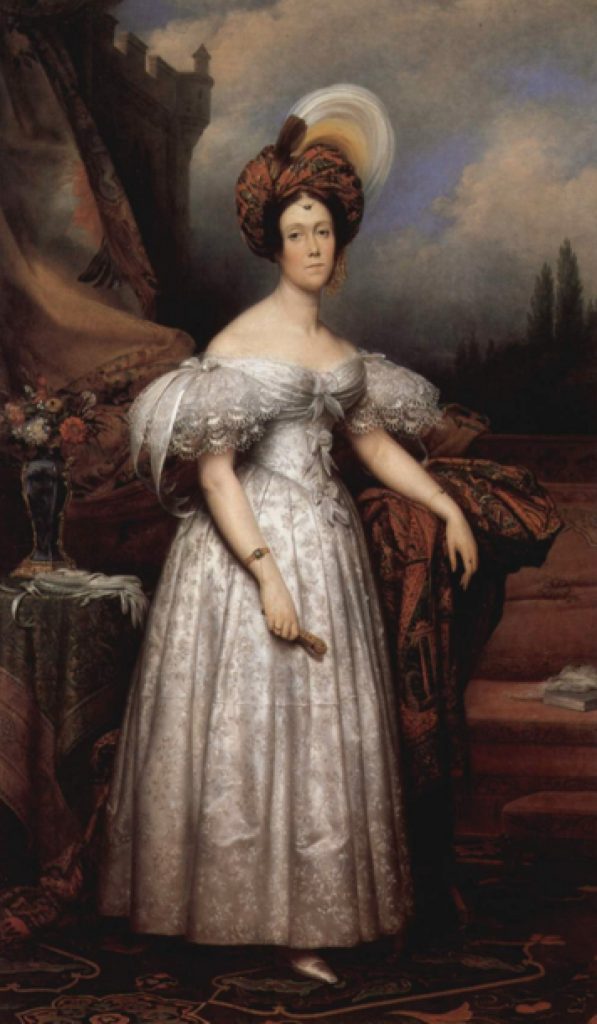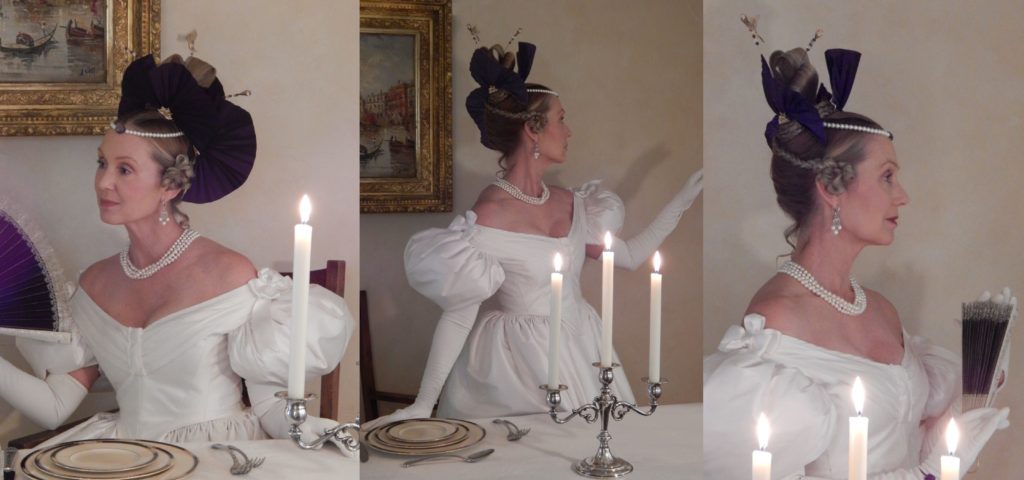The Romantic Era 1815-1840 has some of the most iconic hairstyles of any time period, particularly the evening styles. One can’t get a mental image of the period without thinking of tall loops of hair rising from the crown. But after looking at hundreds of fashion plates, I now think first of curls. Either heaps of small curls framing the face, larger rolled curls placed asymmetrically on either side of the forehead, or two to three long sausage curls hanging from the sideburns.

There are so many hairstyles to choose from, you need look no farther than Ackermann’s: The Repository of arts, literature, commerce, manufactures, fashions and politics to get the scope of the variety. They published 12 issues a year between1809-28, each issue had 2 fashion plates with drawings of: Evening, Dinner, Promenade, Costume (Fancy Dress), Carriage, Cottage, Bridal, Court, Half, Walking, Morning or Day dress. You can access them on archive.org and the figure captions that go with the plates are as useful as the plates, maybe even more so. Here is an example of a small section of the caption for October 1827 that describes the headdress. “The hair is dressed in large curls, with plaited bands, arranged between a garland of blue dahlias.” The caption tells you about the hairstyle but also the gown and all the accessories sometimes things you can’t know just from the drawings.

I sampled the headdress sections of these fashion plates for the years 1816, 1820, 1827 and 1828. As you might gather, the 1816 hairstyles are very much Regency hairstyles. As many younger women would have cut their hair short for the Titus style just a few years earlier, the styles do not requite hair more than 4” long. The 1827 and 28 styles usually require hair long enough to pull the majority into a twist at the top of the crown, perhaps 10” long. But as you will see later in my article, the rest of the hairstyle can be quickly achieved with hairpieces regardless of the length of your natural hair.




Fashion plates of this time period are somewhat limiting as they show almost exclusively young women of a particular class. If you are costuming to recreate a character or historical person, then you need to take some things into consideration like: age, class, how fashionable on unfashionable the women were, and how much access to fashion news the person might have had. As an example, even a women from the most wealthy family in pre-gold rush era San Francisco would not get her fashion magazines until they were at least one year out of date.

Lady Stuart and her daughters by George Hayter is an example of women of different ages with different styles.
I would also recommend searching on-line collections of museums for portraits and miniatures to research how greater ranges of women were styling their hair during this era. Portraits were not limited to royalty and the super wealthy, although they do make up the majority, but with miniatures, you can see more upper middle class and middle class women. A few good places to start your research are the National Portrait Gallery (UK), The Smithsonian, Metropolitan Museum of Art, and The Victoria and Albert Museum. I also found that a Google search for “miniature portraits 1830s” gave me quite a few nice choices. If you check out WikiArt, look for these Romantic Artists: Vasily Tropinin, Orest Kiprensky, Karl Bryullov, Miklos Barabas just to name a few.
Romantic hairstyles slowly evolved from Regency styles in the late teens, to purely Romantic in the mid 20s, and then to increasingly complex Romantic in the late 20s. Hairstyles stayed this way for almost a decade. By the very late 30s, the styles changed to what we would consider Victorian (more on the change later). Many of the same elements can be seen throughout the period, like loops of braided, twisted, plain hair or ribbon, which became more elaborate and vertically exaggerated in the decade from the late 20s to the late 30s.
Elements of a Romantic Hairstyle
Buns/top knots/Apollo’s knots

The buns from this time period were worn near the top of the head and are where the hairstyles get their vertical exaggeration. But there are so many different buns from this time period that I can’t cover them all. I have two to show for evening and a few more for the day styles. Often the buns are all, or in part, styled with hairpieces.
Parts
Unlike some time periods where there is often a dominant choice of what is in style and what is out, in the Regency anything goes. Parts can range from a simple center part, to a very off center part, even some very complex parts. I have used three different parts in the evening style below.

In this portrait of Henrietta Sontag by Paul Delaroche
she has a part that starts out as a center part and then forks out to either side.

An example of a very complex part it has a center part and two angle parts. The Hon. Mrs. Caroline Norton, society beauty and author, 1832
Back
The hair treatment options are a little more difficult to determine. It is relatively rare to find fashion plates and paintings that show women from the back, but from “The Mode in Hats and Headdresses” had some to choose from. I have chosen to show the crossover for evening and the crossover and French twist for everyday.

A day look with the majority of the head covered except for curls at the temples, by Orest Kiprensky

An evening look with the majority of the head covered except for curls at the temples, Marquise de Béthisy als Orientalin
Ornaments
Flowers were the most used ornaments for an evening headdress. But a long list of other things also shows up among them such as: ribbons, feathers, miniature crowns, other jewelry and fans.

References:
An Illustrated Dictionary of Hairdressing & Wigmaking
by Cox ISBN 0713442093
An Illustrated History of Hairstyles 1830-1930
by Marian I. Doyle ISBN 0764317342
English Women’s Clothing in the Nineteenth Century
By C. Willett Cunnington ISBN 0486263231
This book shows the changes in the 19thC year by year with 6 line drawings per year of the hats and headdresses.
The Mode in Hats and Headdress
by R. Turner Wilcox ISBN 0486467627
Do you mind if I quote a few of your posts as long as I provide credit and sources back to your webpage? My blog is in the exact same niche as yours and my visitors would certainly benefit from a lot of the information you present here. Please let me know if this okay with you. Thanks a lot!
Sure, with credit you can. I suggest you link to this page <https://outofaportrait.com/home/articles/period-hairstyling-articles/> it the entry to all the articles and I will be adding some bustle era hairstyles to this page soon. Lynn
I had no idea that the hairstyles of the period were so sculptural. I have to say the most fascinating part was the use of polyurethane to stiffen the Apollo’s knots/loops. I’m curious as to the origin of the name, though…
As the 1830s are at the end of a Neo Classical period I can think of other fashion/hairstyle terms that come from the Greek or Roman. Like the titus hair style and the cap I working on now which was called a Spartan Cap.